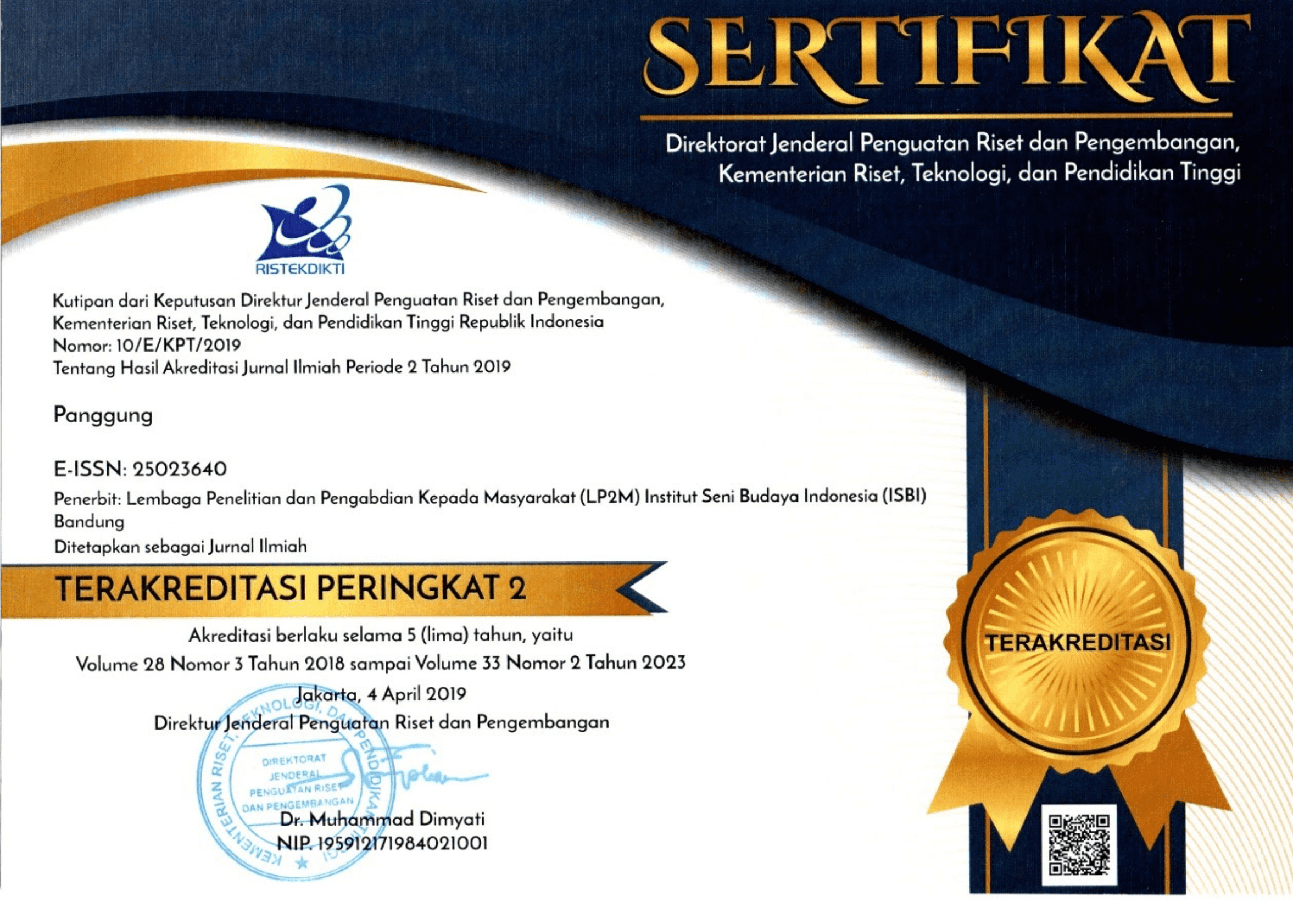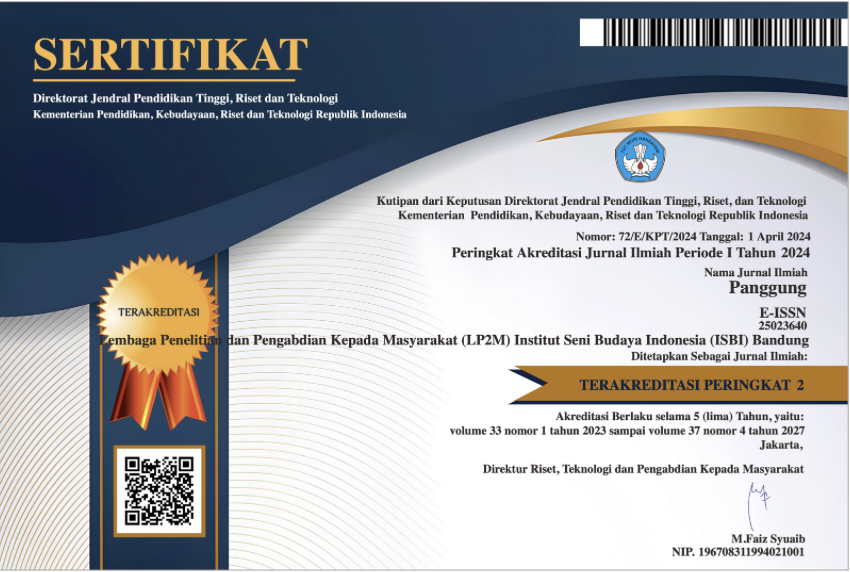Kreativitas Desain Kuliner dan Sistem Inovasi Lokal
DOI:
https://doi.org/10.26742/panggung.v24i3.125Abstract
ABSTRACT
Â
The development of creativity in a particular social group, class or community is higly deter- mined by certain capitals invested in the field of creativity: economic, cultural, symbolic and social. This research is an attempt to understand creativity as a part of particular socio-cultural setting, namely a ‘field of creativity’. By employing an ethnographic method, this research is an attempt to analyse the relationship between creative ideas and socio-cultural context in which the ideas are pro- duced. Through an intensive field research in local creative communities, this research concludes that creative ideas are higly determined by the comprehensiveness of creative fields: expression, produc- tion, dissemination and aprreciation. From these creative fields, three models of system of innovation can be proposed: an open system, liminal system and closed system.
Â
Keywords: creative idea, field, innovation, capital
Â
Â
Â
Â
ABSTRAK
Â
Pengembangan kreativitas pada sebuah kelompok, kelas sosial atau komunitas sangat ditentukan oleh modal yang diinvestasikan dalam ranah kreativitas: ekonomi, budaya, sim- bolik dan sosial. Penelitian ini adalah upaya untuk memahami kreativitas sebagai bagian dari ranah khusus sosial-budaya, yaitu ‘ranah kreativitas’. Dengan menggunakan metode etnografi, penelitian ini adalah upaya untuk menganalisis relasi antara ide-ide kreatif dan konteks sosial-budaya di mana ide-ide itu diproduksi. Melalui penelitian lapangan yang intensif terhadap komunitas kreatif lokal, penelitian ini menyimpulkan, bahwa produksi ide-ide kreatif sangat ditentukan oleh kelengkapan sub-sub ranah yang membangun ranah kreatif: ekspresi, produksi, diseminasi dan apresiasi. Berdasarkan ranah-ranah kreatif ini, tiga model sistem inovasi dapat diajukan: sistem terbuka, sistem liminal dan sistem tertu- tup.
Â
Kata kunci: ide kreatif, ranah, inovasi, modal
References
Bourdieu, Pierre
A Social Critique of the Judgement of
Taste. US: Harvard University Press
---------------,
Language and Symbolic Power. Cam- bridge: Polity Press
---------------,
The Field of Cultural Production. Cam- bridge: Polity Press
Csikszentmihalyi, Mihaly
Flow: The Psychology of Optimal Expe- rience. New York: Harper Perennial
---------------,
The Evolving Self: A Psychology for the Third Millenium. San Fransisco: Har- per Perennial
---------------,
Creativity: Flow and the Psychology of
Discovery and Invention. New York:
Harper Perennial
Florida, Richard
The Rise of the Creative Class. Mel- bourne: Pluto Press
Harker, Richard (ed)
An Introduction to the Work of Pierre
Bourdieu. MacMillan
Howkins, John
The Creative Economy: How People Make Money From Ideas. Penguin Books
Yasraf Amir Piliang
“Creativity as the Conceptual and Pragmatic Framing of Mindâ€, Inter- national Journal Melintas, Vol 27, No 2
Downloads
How to Cite
Issue
Section
Citation Check
License
Penulis yang menerbitkan jurnal ini menyetujui persyaratan berikut:
Penulis memiliki hak cipta dan memberikan jurnal hak publikasi pertama dengan karya yang secara simultan dilisensikan di bawah Creative Commons Attribution License yang memungkinkan orang lain untuk berbagi karya dengan pengakuan kepengarangan karya dan publikasi awal dalam jurnal ini.
Penulis dapat mengadakan perjanjian kontrak tambahan yang terpisah untuk distribusi non-eksklusif versi jurnal yang diterbitkan dari karya tersebut (misalnya, mempostingnya ke repositori institusional atau menerbitkannya dalam sebuah buku), dengan pengakuan atas publikasi awalnya dalam jurnal ini.
Penulis diizinkan dan didorong untuk memposting pekerjaan mereka secara online (mis., Dalam repositori institusional atau di situs web mereka) sebelum dan selama proses pengiriman, karena dapat menyebabkan pertukaran yang produktif, serta kutipan yang lebih awal dan lebih besar dari karya yang diterbitkan.
Authors who publish with this journal agree to the following terms:
Authors retain copyright and grant the journal right of first publication with the work simultaneously licensed under a Creative Commons Attribution License that allows others to share the work with an acknowledgement of the work's authorship and initial publication in this journal.
Authors are able to enter into separate, additional contractual arrangements for the non-exclusive distribution of the journal's published version of the work (e.g., post it to an institutional repository or publish it in a book), with an acknowledgement of its initial publication in this journal.
Authors are permitted and encouraged to post their work online (e.g., in institutional repositories or on their website) prior to and during the submission process, as it can lead to productive exchanges, as well as earlier and greater citation of published work.





